The Moscow Kremlin is an imposing fortress marking the very core of Russia’s capital city. It is the largest medieval fortress in Europe and a UNESCO World Heritage Site comprising towers, palaces, squares and churches. For centuries, the Kremlin has been a unique monument of Russian culture and a symbol of Russian statehood. Its formidable wallshave housed the seat of Russian power from medieval times to the Romanovs, the Soviets, and the Russian government today. The Moscow Kremlin exudes power and grandeur to all those who visit and is an unmissable landmark for those visiting Russia’s capital city.
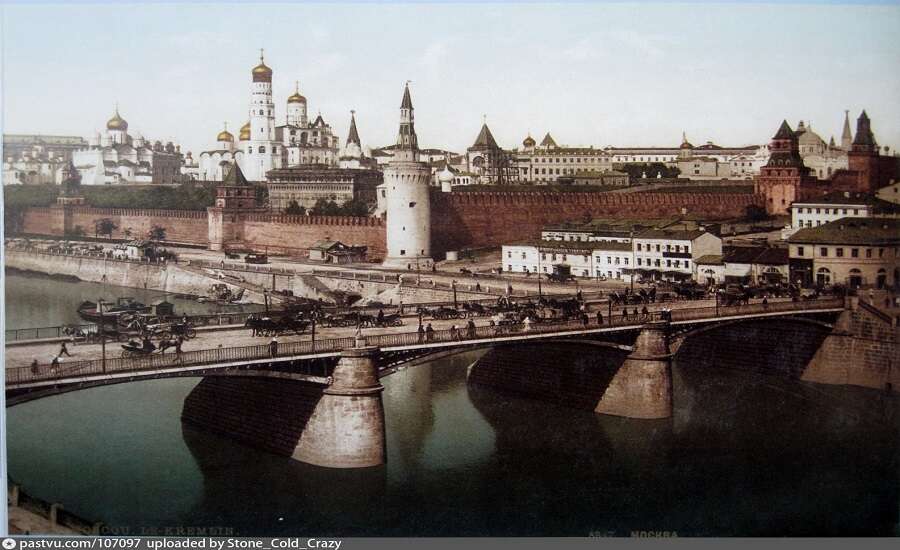
Photo from https://pastvu.com/
The Moscow Kremlin is the oldest part of the city. The first wooden fortress waserected here nearly 900 years ago by Prince Yuri Dolgoruky. It was the seat of Russia’s princes from 1264 onwardsand was replaced with a limestone fortress in 1367 by Prince Dmitry Donskoy. During this time the city was often referred to as ‘White-stone Moscow’.
Did you know? The first settlement which existed on this territory dates back to the Bronze Age! The Borovitsky Hill on which the Kremlin now lies was referred to as ‘Witch Mountain’ in the pagan period.
In the second half of the 15th century, under Ivan the Great, the Kremlin was totally rebuilt in brick, and largely acquired its present appearance and dimensions. By the beginning of the 16th centurythe Moscow Kremlin had become an impregnable fortress embodying the might of Russia’s capital – in some places, the walls are 19 metres high and 6.5 metres thick. You can learn more about this period in Russia here.
Did you know? Many secret underground passages were builtto connect the Kremlin with other important sites in Moscow! This labyrinth is still being uncovered today, as are the skeletons of unlucky explorers…
At the beginning of the 18th century, Peter the Great moved the capital of Russia to St. Petersburg. The Moscow Kremlin retained its significance and, according to tradition, Russian Tsars continued to be coronated there. New palaces and religious buildings were constructed in Gothic and Classical style, mixing ancient and modern architecture in the Kremlin’s ensemble. Italian architects contributed significantly, and at one point there were hanging gardens in the Kremlin! The Kremlin’s first museum was founded in 1806 by Alexander I, to house valuable exhibits from the imperial workshops and armoury.
Did you know? Napoleon entered Moscow during his invasion of Russia in 1812, butonly spent one day in the Kremlin. After fires began tearing across the city, Napoleon escaped via secret tunnels and ordered the Kremlin’s destruction with bombardments so devasting that reconstruction took over 20 years.
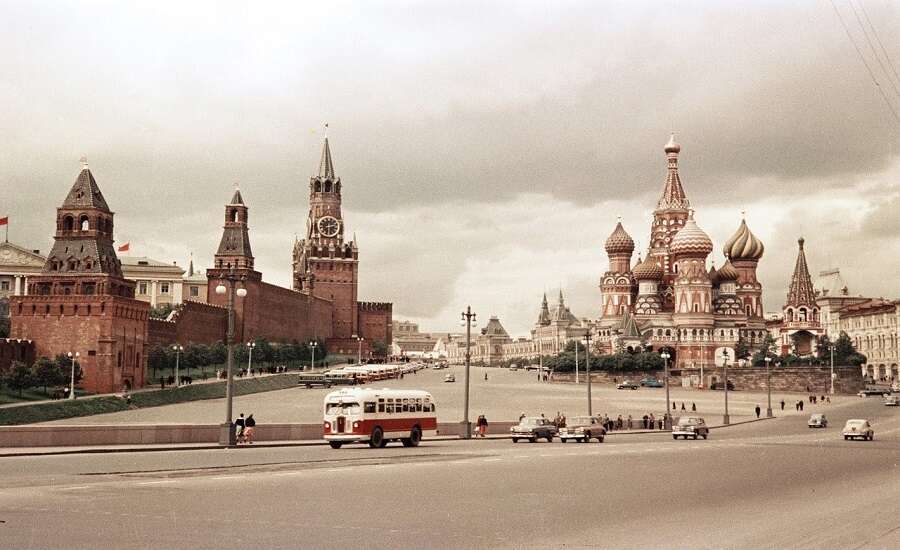
Photo from https://kartinkinaden.ru/
The Soviet government transferred the Russian capital back to Moscow, and Lenin himself moved into the Kremlin, which became the seat of the highest state bodies. Although the Moscow Kremlin had been open to the public by the start of the 1900s, it was soon closed and only those who lived or worked there were admitted.
Did you know? It is rumoured that Lenin’s ghost roams the Moscow Kremlin, and that the ghost was actually first sighted when Lenin was terminally ill.
The Moscow Kremlin, a symbol of imperial might, was significantly damaged during the Soviet period. The ensemble’s 31 churches were looted for their valuables anda series of purposeful demolitions of its ancient buildings were organised, despite the opposition ofhigh-up members of the government. More than half of the Kremlin’s buildings no longer stand today.
To protect the Moscow Kremlin during the Second World War, the Soviet government disguised it! The grand buildings were concealed as residential streets, roofs were painted on open spaces,crosses were removed from the churches and their gilded domes painted dark, andthe most famous buildings were covered with camouflage sheeting to hide their distinctive silhouettes. Nearly 200 bombs were dropped on the Kremlin, but no catastrophic damage was done.
Did you know? Lenin’s body was transported to Tyumen during wartime and was finally returned to Moscow in March 1945.
The Kremlin was finally reopened to the public in 1955 and was designated a museum in 1960. The next few decades were dedicated to developing the museum of the Moscow Kremlin, establishing a research institute, archive and library, organising exhibitions, and restoring the unique architecture of the Kremlin’s ensemble. The Moscow Kremlin was declared a UNESCO World Heritage Site in 1990.
Did you know? Shortly after the end of the Second World War, Winston Churchill tried to persuade the Americans to drop an atomic bomb on the Kremlin to halt the threat of Communism!
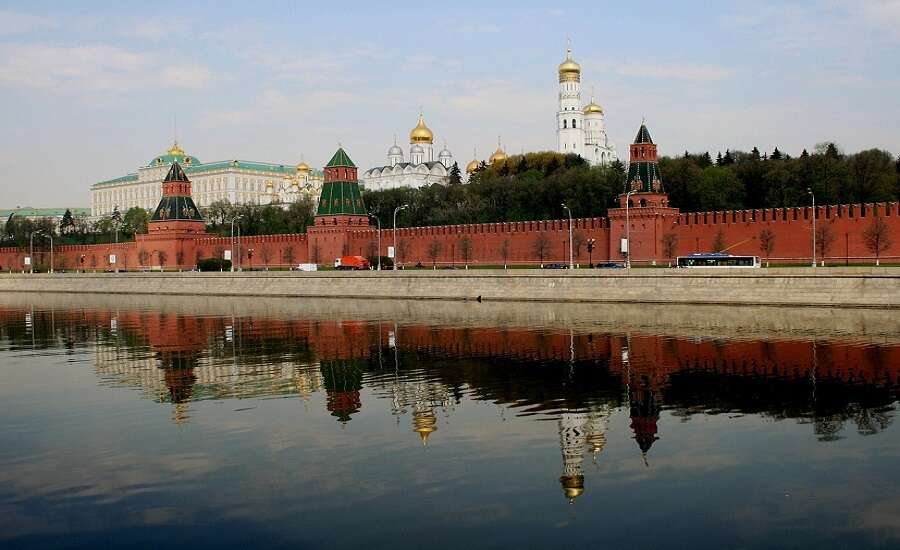
Photo by Lynn Greyling website Pixabay
The Kremlin has been the residence of the President of the Russian Federation and his administration since 1992. Since the collapse of the USSR, services have resumed in the cathedrals and the Kremlin bells which fell silent for over 70 years have once again come to life.
The Moscow Kremlin comprises over 2 kilometres of impenetrable walls punctuated by 20 towers. Each has its own unique history and design. Its most interestingtowers include:
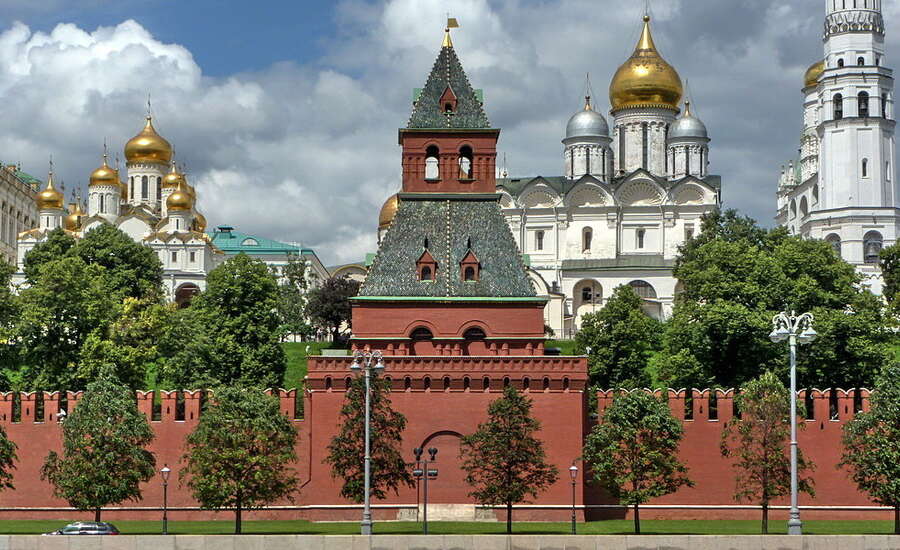
Photo from http://mosprogulka.ru/
The Kremlin’s first tower, built in 1485. Its name derives from the word taina, meaning ‘secret’:a well and secret passage were dug under the tower to provide water and an exit during sieges. Between 1930 – 1933 these were filled in.
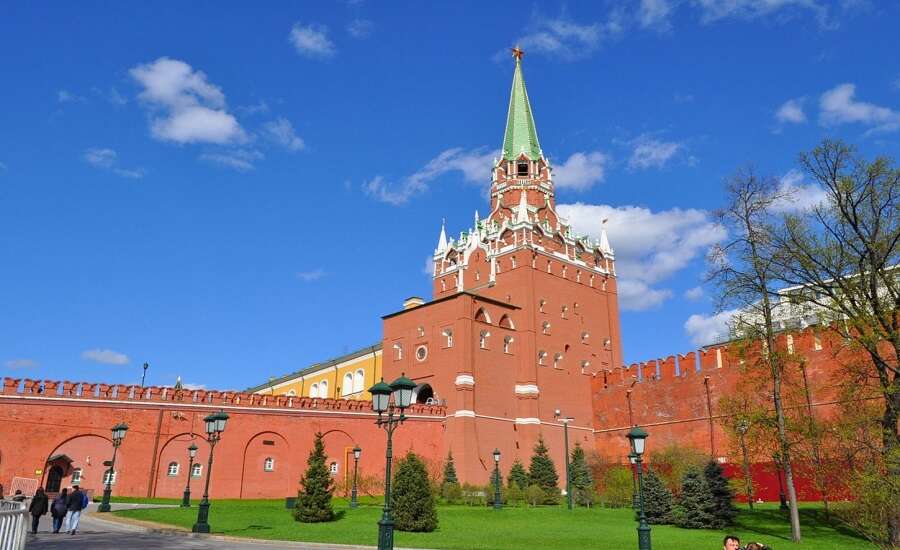
Photo from https://architectureguru.ru/
The tallest tower in the Kremlin, standing 80 metres tall. As well as having a defensive functionthe tower’s gate served as a passage for the royal family and clergy. An enormous red star was installed atop the tower in 1937 where it remains to this day, lit from inside with bright lamps.
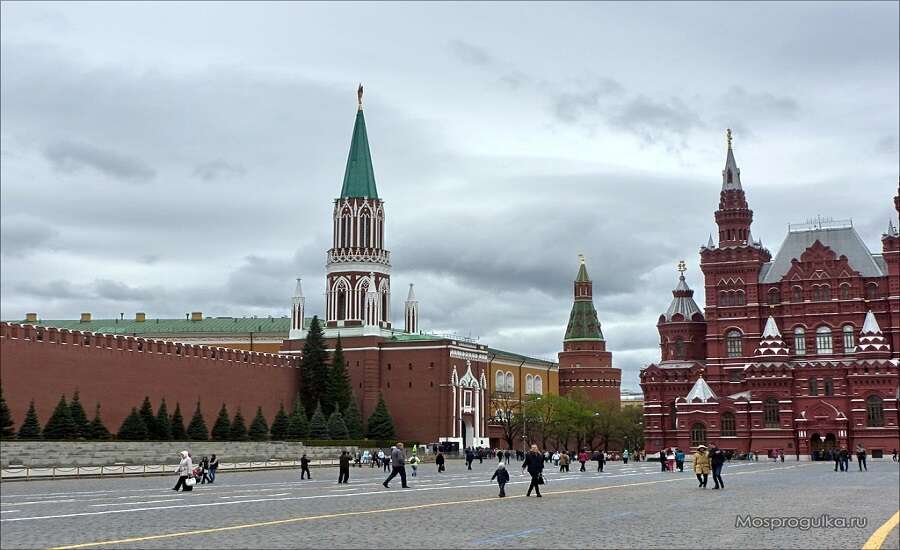
Photo from http://mosprogulka.ru/
An octagonal tower constructed in ornate Gothic style, with lace-like embellishments and narrow arches stretching to a steep green spire. Despite suffering serious damage during the war of 1812 and the revolution, the tower has been restored.
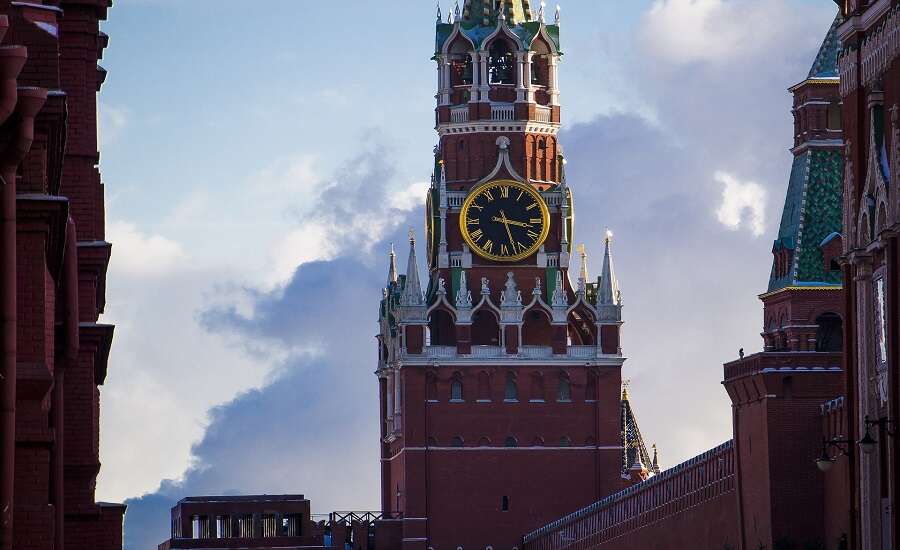
Photo by Денис Кулягин website Pixabay
The most famous tower of the Kremlin ensemble, which sits at the ancient Kremlin’s main gate. Initially known as the Frolovskaya Tower, royal processions, military marches and ambassadorial receptions took place here. It is adorned with white stone towers, statues, and columns.
Did you know? An enormous clock occupies the tower's top three storeys, weighing 25 tons! The clock hands are around 3 metres in length and the numbers are 72 centimetres tall. The clock’s famous chimes can be heard from far around, and twice a day they play the national anthem and Glory from Glinka’s opera A Life for the Tsar.
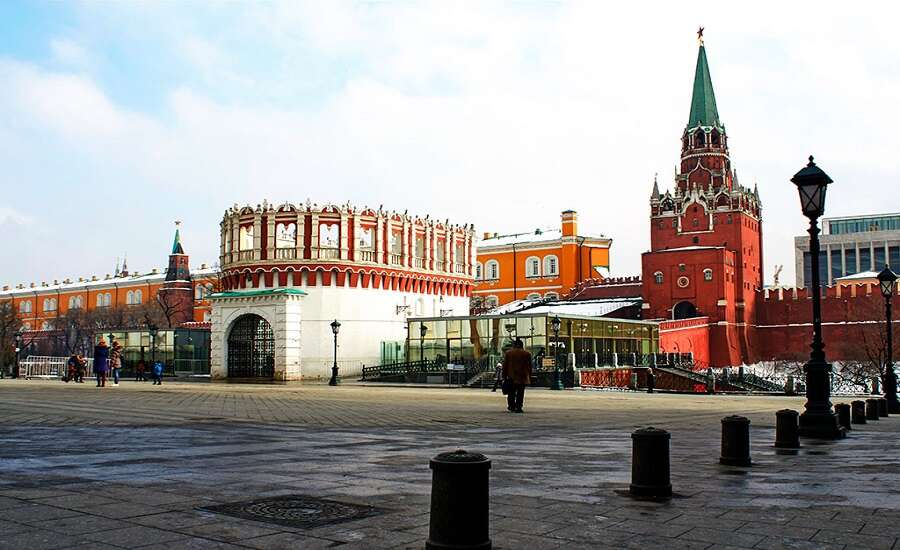
Photo from https://architectureguru.ru/
An unusually shapedtower whose portcullisand battlements protected the entrance to the Kremlin via the Troitskaya Tower. The tower was surrounded by water which frequently rose far up its walls, giving it a heavy and squat appearance.
Did you know? The tower’s name, Kutafya, originates from an old Russian wordmeaning an unattractive and clumsy woman.
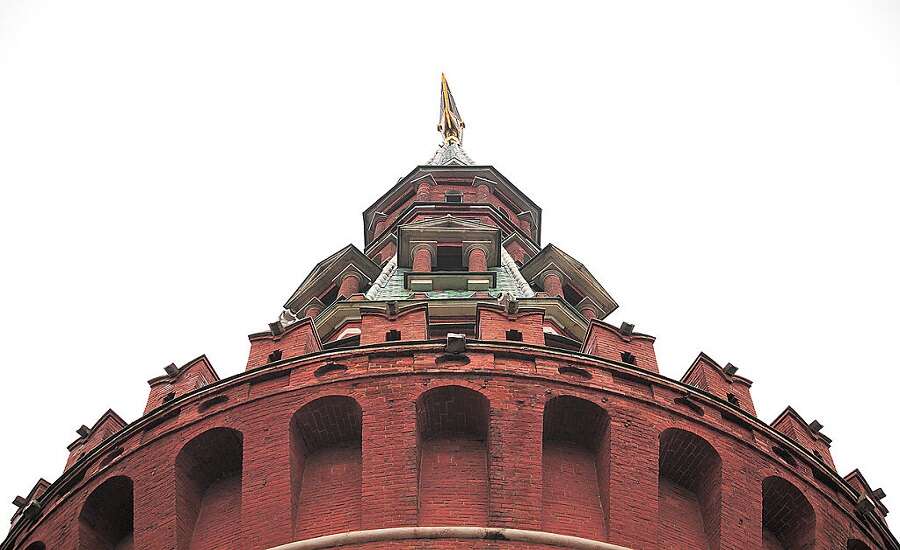
Photo from https://www.dxfoto.ru/
Initially named the Sviblova Tower after the Sviblo boyar family whose court adjoined the tower, it was renamed after Moscow’s first water-drawing machine was installed there to distribute water throughout the Kremlin (vozvodit means ‘to raise’ in Russian).The imposing green and terracotta tower stands at the Kremlin’s south-western corner.
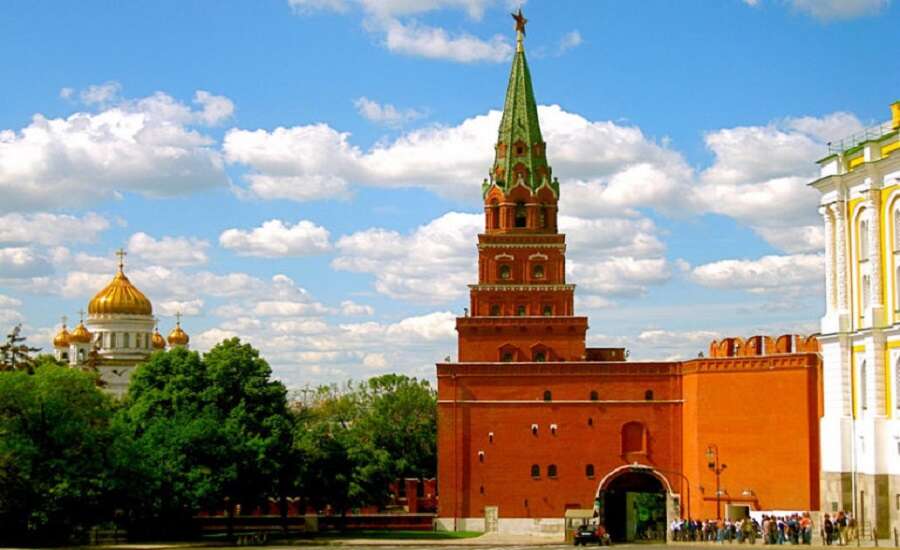
Photo from https://architectureguru.ru/
One of Moscow’s oldest buildings, constructed in 1490. According to legend, the tower's name was related to adense coniferous forest that covered the top of the Borovitsky Hill in ancient times. The Borovitskaya Tower houses the only gate currently used by the Russian presidential motorcade.
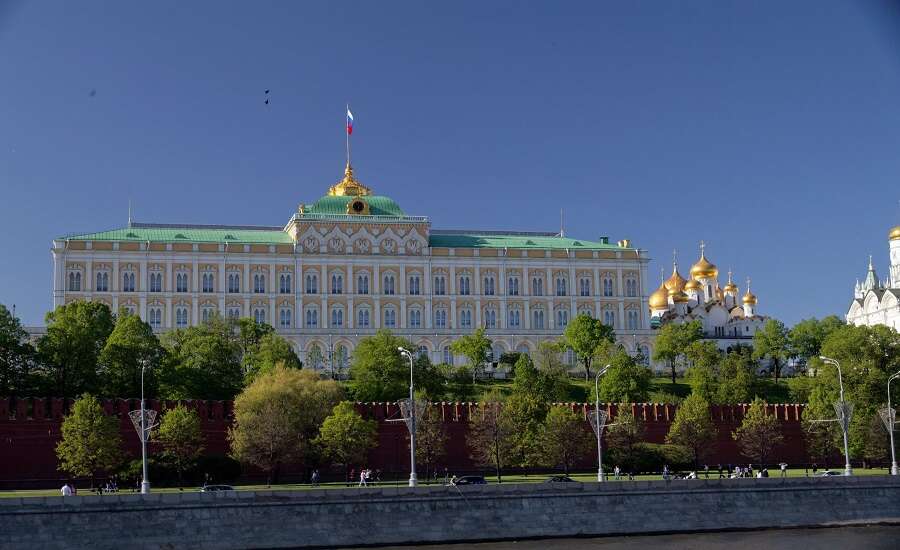
Photo from https://ingusspb.ru/
The largest palace on the territory of the Kremlin, housing the Russian imperial residence, the Soviet government, and now the ceremonial residence of the President of Russia. It stands on the crest of BorovitskyHill and incorporates secular and sacred edifices amongst its magnificent buildings and halls. The palace is only accessible via a private tour.
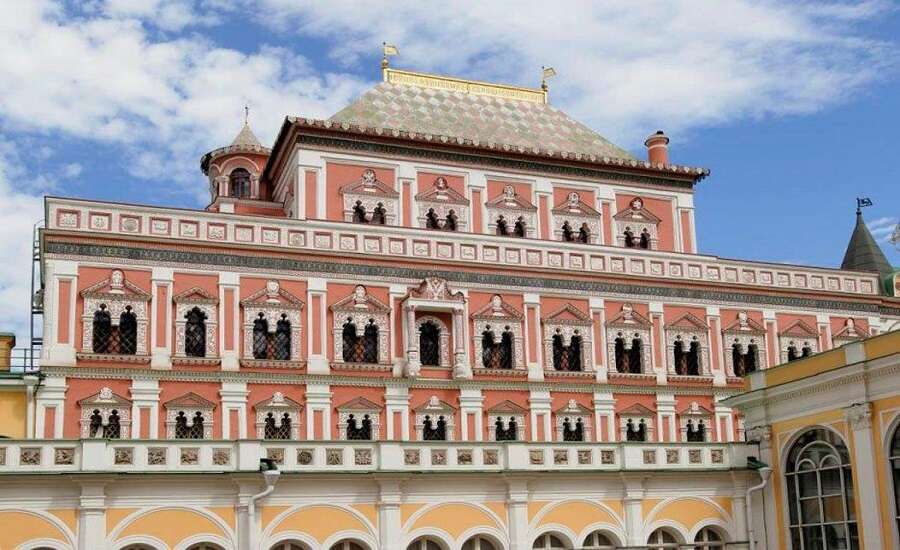
Photo from https://kremlin-architectural-ensemble.kreml.ru/
The primary residence of Russia’s 16th century rulers. The Terem Palace boasts spectacularly colourful interior decoration with oriental patterns, carvings and even stained glass. Visitors can also admire its interesting exterior, a synthesis of Russian and Italian architecture ina tiered structure embellished with archways, cornices, galleries, carvings and tiles. Only accessible via a private tour.
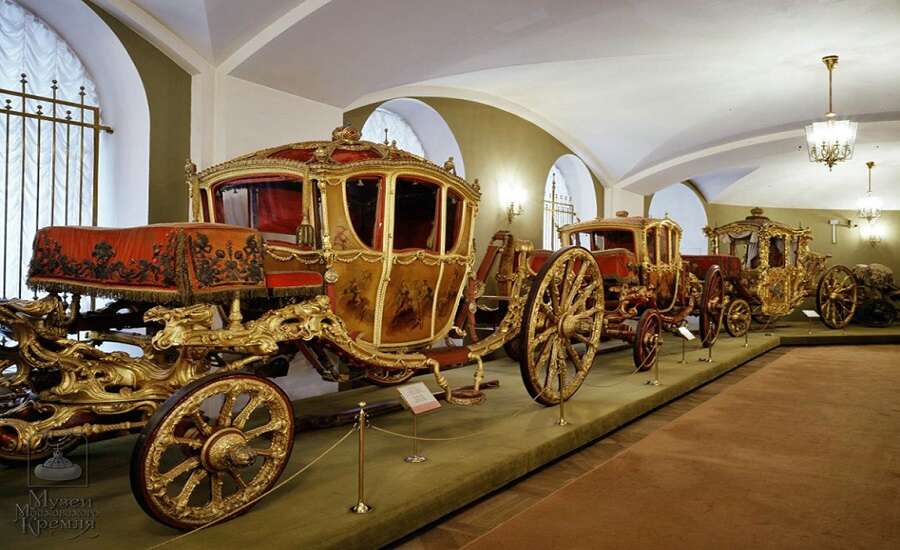
Photo from https://www.kreml.ru/
A huge museum whose collection began in the 1300s, the armoury displaysfour thousand exhibits from the imperial family’s treasury including ambassadorial gifts, textiles and garments, religious items,gold and silver applied art, armour and weapons.
Many white stone cathedrals and churches sit around the Kremlin’s Cathedral Square.
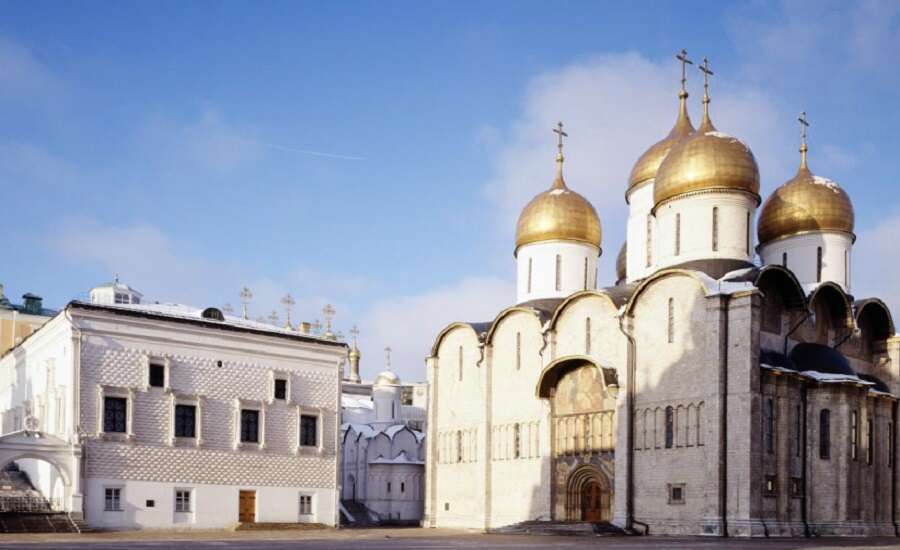
Photo from https://www.kreml.ru/
The main cathedral of the Russian Empire for hundreds of years. Coronations of tsars and inaugurations of Russia’s patriarchs took place underneath its domes. Outstanding examples of Russian medieval art cover the interior walls and five gilded domes sit atop its roof.
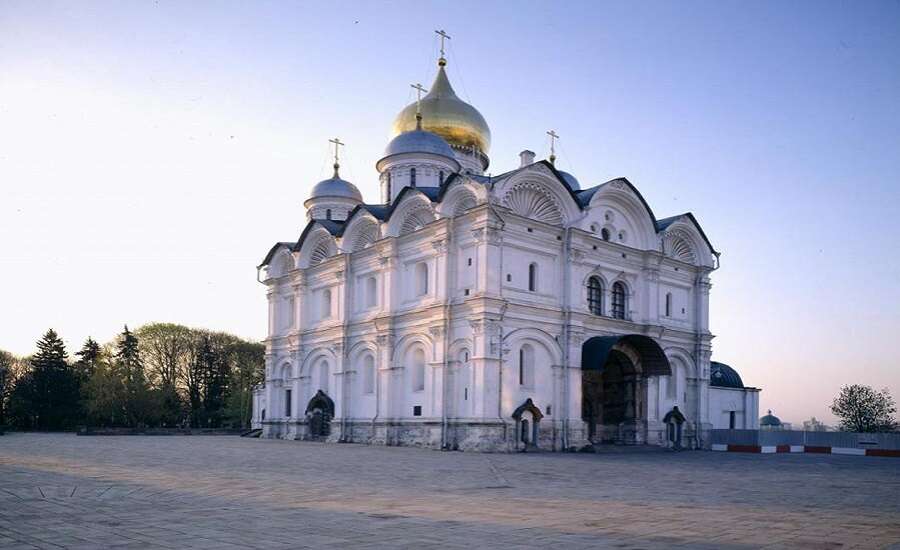
Photo from https://www.kreml.ru/
The church of Russia’s Grand Princes. There are more than 60 mural portraits of the princes decorating the cathedral’s interior and many were laid to rest inside. After being crowned, Russia’s new tsars would proceed to the Archangel Cathedral to honour their ancestors.
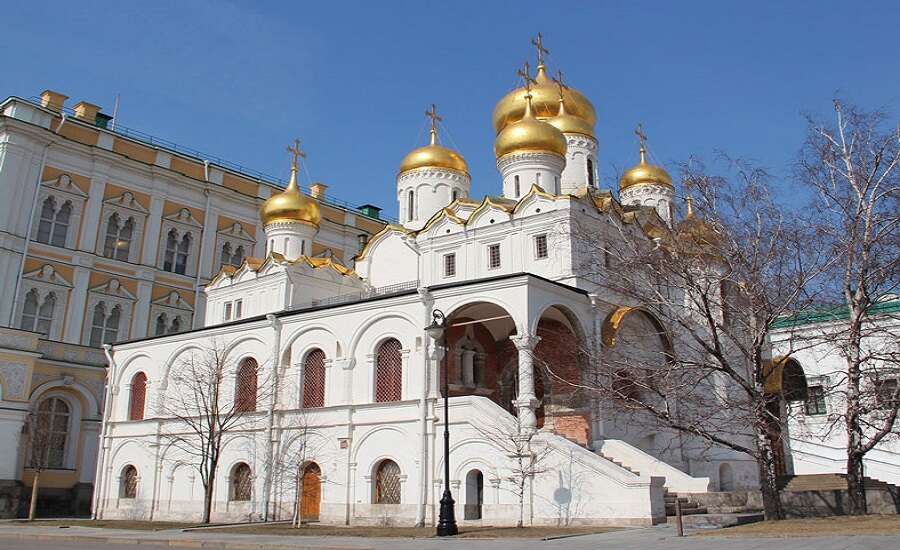
Photo from https://www.kreml.ru/
Despite its small size the Annunciation Cathedral is one of the Kremlin’s most special,constructed as the personal church of the royal family.Underneath its many gilded domes stands one of Russia’s oldest iconostases, its basement houses an exhibition of the Kremlin’s treasures and antiquities, and the walls are unusually decorated with paintings of Greek philosophers.
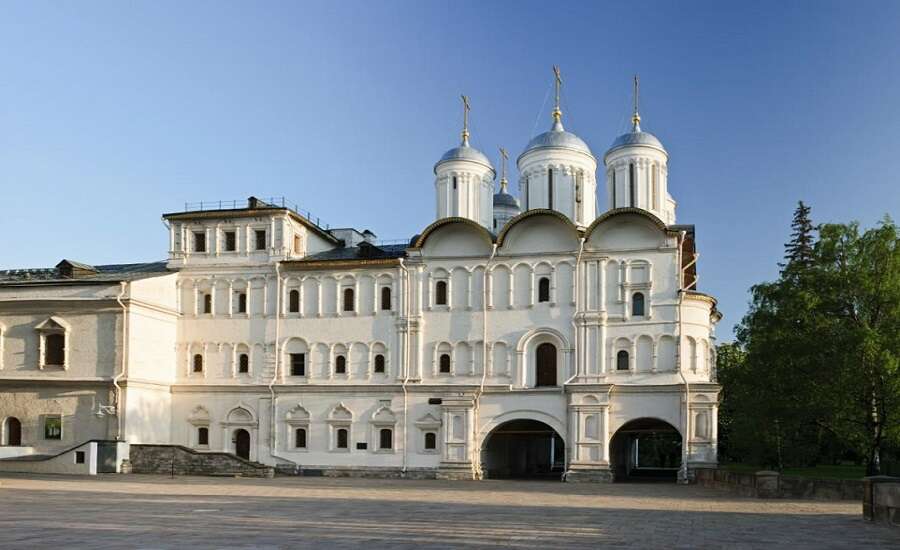
Photo from https://www.kreml.ru/
This church was the private chapel of the Russian Orthodox Patriarch and houses an exhibition of 17th century icons created by the Russian masters. It adjoins the Patriarch Chambers, a rare example of Muscovite civil architecture in the 1600s which was the palatial residence of Russia’s patriarchs.
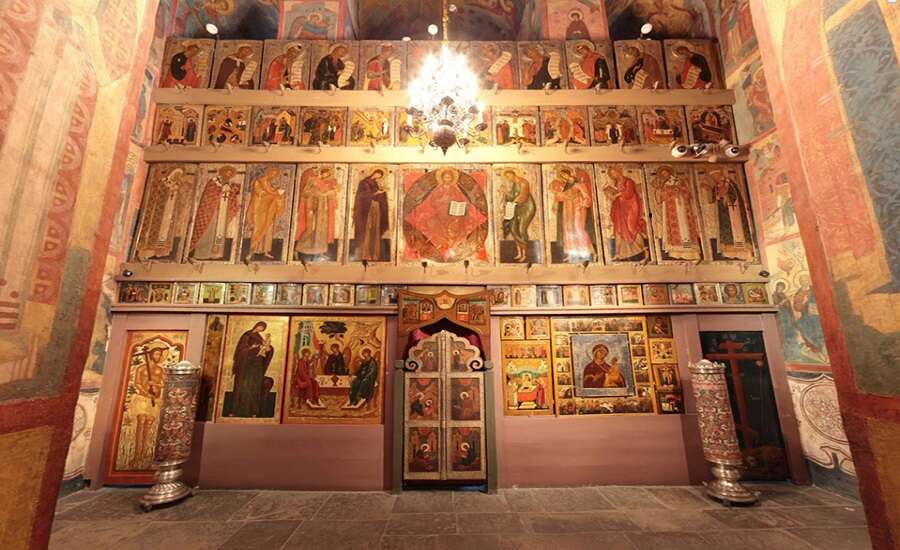
Photo from https://www.kreml.ru/
A tiny church with one gilded dome. Inside are painted frescos and an exhibition of rare Russian woodwork from the 15th – 19th centuries.
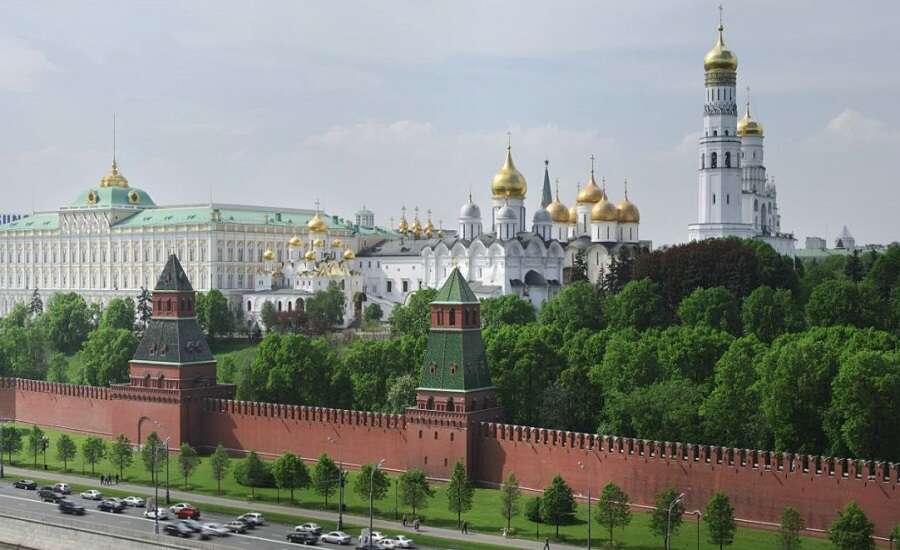
Photo from https://www.kreml.ru/
The most striking building of the Cathedral Square. Its belfry dominates the ensemble, an octagonal tiered tower reaching 81 metres in height and housing 24 bells, including the mighty 65-ton Uspensky bell. Various Russian art exhibitions can be found inside the church, as well as an exhibition about the history of the Moscow Kremlin.
Did you know? The world’s largest bell is located in the Kremlin near the Ivan the Great Bell Tower. The Tsar Bell is 6 metres tall and weighs over 200 tons!
Address and Contact Details
The Kremlin, Borovitskaya Ulitsa, Moscow, 103073
Tel: Excursion office +7 (495) 695-41-46
Website: www.kreml.ru/en/
Metro: Borovitskaya/Biblioteka Imeni Lenina/Alexandrovsky Sad,
Teatralnaya/Ploshchad Revolutsii/Oxotny Ryad
Opening Hours
10.00-17.00. Ticket office open from 9:30 –16:30
Closed Thursdays
Visit the Kremlin website for opening hours of specific exhibitions and buildings
Join us on Facebook
We invite you to become a fan of our company on Facebook and read Russian news and travel stories. To become a fan, click here.
Join our own Russian Travel, Culture and Literature Club on Facebook. The club was created to be a place for everyone with an interest in Russia to get to know each other and share experiences, stories, pictures and advice. To join our club, please follow this link.